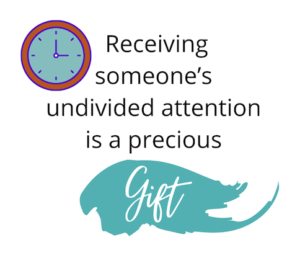With anxiety and depression on the rise today, it is undeniable how isolated and lonely many people are feeling. The roller coaster of this pandemic can leave each of us feeling exhausted and yearning to be seen, heard, and understood by another human being. To counter feelings of isolation, shouldn’t we be seeking tools that will help build bridges of emotional connection?
During my work with clients, I receive numerous opportunities to slow down, be present, listen, and hear about the various stressors in their lives. The intense demands of life have many people feeling as though they’re running as fast as they can – but getting nowhere.
Larry Dossey, M.D., the author of Space, Time & Medicine, uses the term “hurry sickness” to describe people’s over-concern for schedules, deadlines, and the ongoing ticking of the clock. This intense focus on external time can cause a buildup in internal pressure. Dossey cites hurry sickness in the rise of stress-related problems, such as heart disease, high blood pressure, and depression.
In addition to offering hypnotherapy, I teach Assertive Communication Skills to many of my clients. Listening compassionately is one of the important “Life Tools” that I focus on when teaching assertiveness. This is a wonderful tool to share because:

When I was a kid, thankfully I always had plenty to eat, but sadly neither of my parents knew how to offer emotional nourishment or emotional connection. If my dad wasn’t at work, then he sat at home reading (and hiding behind) a newspaper. My mother, on the other hand, appeared to be very uncomfortable if she wasn’t moving a hundred miles an hour while cleaning or cooking.
Although I admire a strong work ethic, I have to tell you that in my life today:
I absolutely treasure
~ D-E-E-P ~
heartfelt conversations
with my clients &
dear friends.
So, the next time you have an opportunity to connect deeply with someone, I hope you’ll remember the importance of emotional connections and turn off the TV, the computer, and put down your cell phone or your book.
Gift the person with your glorious, undivided attention. When you seek to deeply understand someone, you’ll be practicing Active Listening, which is a focused way of receiving information from another. By contrast, passive listening or robotically, “Uh-huhing…” as a form of listening contains little action and the communication is basically stuck on autopilot.
~ The Simple Steps of Active Listening ~
One of the keys to success when offering the GIFT of Active Listening is to pull back your energy from yourself, so you can be fully present for the person you are connecting with. In preparation, if you consciously deepen your breath into your belly, it will help you get grounded. Then you can receive information from the other person more effectively.
 1. Mirroring:
1. Mirroring:
After the person you are listening to is finished sharing, repeat (reflect) what you have heard him or her say. This will let the person know you are fully present and listening. Paraphrase the person’s content in your own language. You might begin with: It sounds like…, I hear that…, I see that…
 2. Validation:
2. Validation:
This requires listening for the feeling that is oftentimes underneath the content of his or her sharing. Mindfully hold back judgment or criticism during this step and simply validate the person’s emotions. You might validate by saying: I can see how…, It makes sense that…, I can understand why…
 3. Empathy:
3. Empathy:
Consider what it would be like to walk in the shoes of the other person. Be aware of how your body reacts to what you hear. This will give you more information and empathy toward what he or she has been through. You might empathize by saying: I feel for what you’re going through right now…; My heart goes out to you and your family…
Active Listening is an opportunity for you to do your best to see, hear, and understand the person you are connecting with. Try to let go of as many preconceived ideas and judgments about this person as you possibly can.
Bless them with your full attention and don’t interrupt while they are sharing. And keep in mind, with the fast-paced nature of many conversations, it may take some practice to contain your responses and not eagerly want to grab the microphone!
Toxic Positivity
Another form of communication that is a popular topic in the press today, is “Toxic Positivity.” The Psychology Today website defines toxic positivity as:
“the act of avoiding, suppressing, or rejecting negative emotions or experiences. This may take the form of denying your own emotions or someone else denying your emotions, insisting on positive thinking instead. Although setting aside difficult emotions is sometimes necessary temporarily, denying negative feelings long term is harmful because it can prevent people from processing their emotions and overcoming their distress.
“Of course, there’s nothing wrong with showing positivity, optimism, and gratitude – those traits help humans flourish. Positivity only becomes problematic when it functions to reject negative emotions – a if someone responded to a disclosure of distress, for example, with ‘It’s all for the best,’ ‘Just try to be positive,’ or ‘Good vibes only!’”
Let’s face it, we’ve all probably offered positive feedback that we were HOPING would be helpful and uplifting to our friends and families (that was well intentioned). After all, it’s hard watching someone we care about suffer, right? So why wouldn’t we want to offer “good vibes?”
The reason to avoid “good vibes only” is because Toxic Positivity can harm people and relationships. When people are going through challenging times, they need to share authentic human emotions and not feel invalidated or experience someone’s attempts to be “talked out of” what they are feeling. Folks in the midst of challenge or trauma need support through understanding, compassion, and connection.
How Toxic Positivity Can be Harmful
- It can create guilt and shame, by sending a message that the person struggling “should” be above feeling upset about their challenges.
- It can glorify powerful emotions (and being “in control”) while discounting the courage it takes for many people to acknowledge vulnerable emotions.
- It can create a distance between people and a deeper sense of isolation (and loneliness) for the person who’s suffering.
Active Listening vs Toxic Positivity
Keep in mind that attentively listening to the people in your personal and professional life can deepen relationships. And if Toxic Positivity starts creeping into your serious conversations, shift gears from head into heart.
Finally, by choosing Active Listening, you’ll be building vibrant bridges of emotional connectedness. And in case you haven’t heard, connectedness is clinically proven to be a stress reducer – which is great for your health and wellbeing!
~ ~ ~ ~ ~ ~ ~ ~ ~ ~ ~
The Steps of Active Listening are an excerpt from my book: Stress Reduction Journal: Meditate and Journal Your Way to Better Health.
To read an excellent article called, The Cure for Toxic Positivity → click here.


